-
Solutions
-
By District Priority
-
-
Products
-

AI Perceptions and Readiness Survey
Understand stakeholder priorities, familiarity, and readiness to use AI in schools.
-
Resources
-
Featured Resource

Panoramic 2026 Virtual Summit
Discover how educators and leaders are putting purpose behind AI to drive real improvements in attendance, literacy, and student supports.
-
Find Your State
-
-
Alabama
-
Alaska
-
Arizona
-
Arkansas
-
California
-
Colorado
-
Connecticut
-
Delaware
-
Florida
-
Georgia
-
Hawaii
-
Idaho
-
Illinois
-
Indiana
-
Iowa
-
Kansas
-
Kentucky
-
Louisiana
-
Maine
-
Maryland
-
Massachusetts
-
Michigan
-
Minnesota
-
Mississippi
-
Missouri
-
Montana
-
Nebraska
-
Nevada
-
New Hampshire
-
New Jersey
-
New Mexico
-
New York
-
North Carolina
-
North Dakota
-
Ohio
-
Oklahoma
-
Oregon
-
Pennsylvania
-
Rhode Island
-
South Carolina
-
South Dakota
-
Tennessee
-
Texas
-
Utah
-
Vermont
-
Virginia
-
Washington
-
West Virginia
-
Wisconsin
-
Wyoming
-
-
-
About Us
-
Impact
-
Get in Touch
-
Funding & Grants for Panorama
-1.jpg)
Find the Right Tools and Funding for Your Needs
Use the links below to explore funding opportunities for Panorama tools.

Panorama Surveys
Panorama Behavior Logging & Analytics

Panorama Pathways

Panorama Solara
Featured Resource
Toolkit: Funding Resources for District Leaders
Explore this comprehensive toolkit for district leaders, cabinets, and school boards. Discover strategies and resources to navigate the ever-changing funding landscape. Equip yourself with actionable guidance to ensure sustainable funding for student success solutions well into the future.
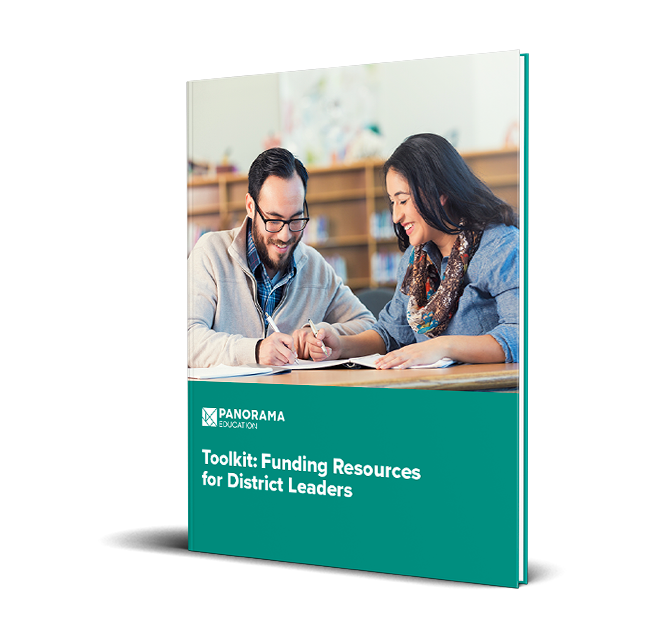
Panorama AI
Panorama Solara
Panorama Solara is a leading customizable, district-wide AI platform that streamlines student supports while ensuring robust data protection and privacy. Tailored to support your district’s goals and practices, Panorama Solara fits seamlessly into your district processes, so it works the way you do.
Explore funding alignment:
- Title I
- Title II
- Title III
- Title IV
- Title V
- Title VI
- IDEA/CEIS
- Perkins V
- GEAR UP
- CARES Act
- Foundation Grants

MULTI-TIERED SYSTEM OF SUPPORTS
Panorama Student Success
Panorama Student Success unifies attendance, academics, life skills, school climate, and behavior in one MTSS platform. Now, teachers and MTSS teams can spend less time on administrative tasks and more time on instruction with students.
Explore funding alignment:
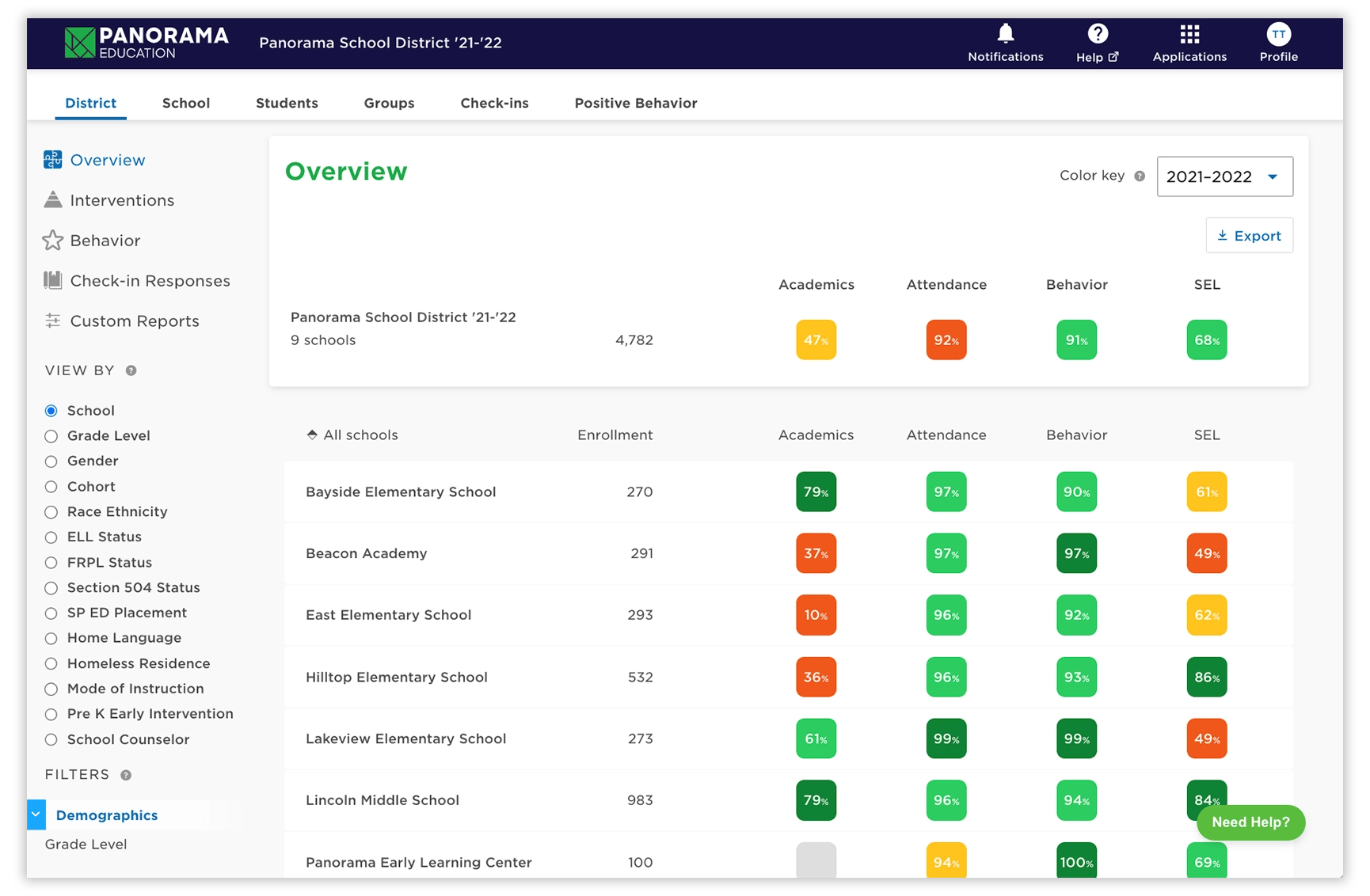
LITERACY AND MATH
Panorama Student Success
Panorama Student Success integrates with screeners and assessments to help districts comply with state legislation. Plus, educators can access the Panorama Playbook to take immediate action with research- and evidence-based math and literacy interventions across all tiers.
Explore funding alignment:
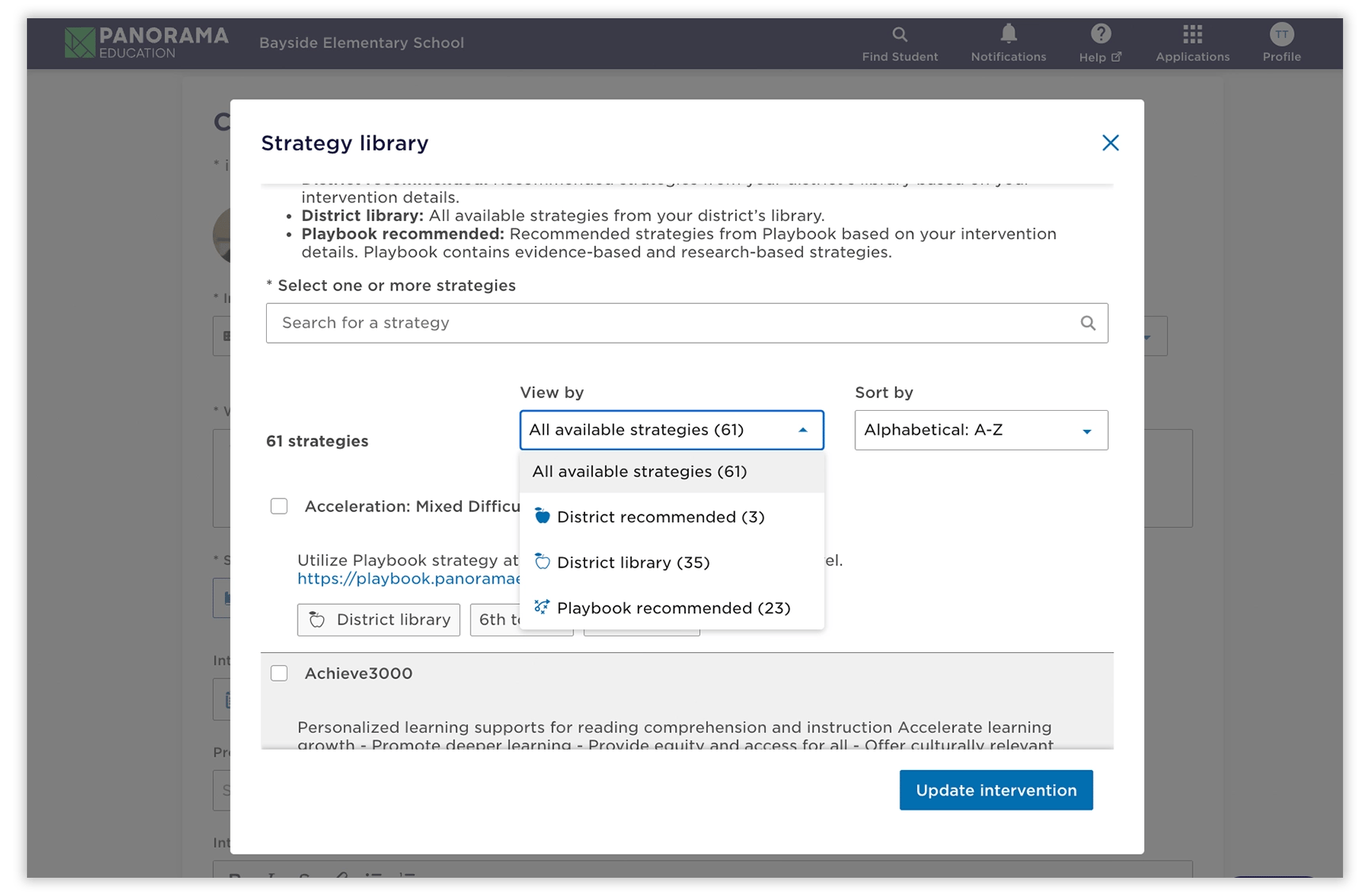
LEARNING LOSS, RECOVERY, AND ACCELERATION
Panorama Student Success
With Panorama Student Success, student data easily travels between schools, so teachers have immediate access to intervention plans, test scores, and reports. Plus, it’s easy to compare spring and fall universal screenings to ensure no students fall through the cracks.
Explore funding alignment:
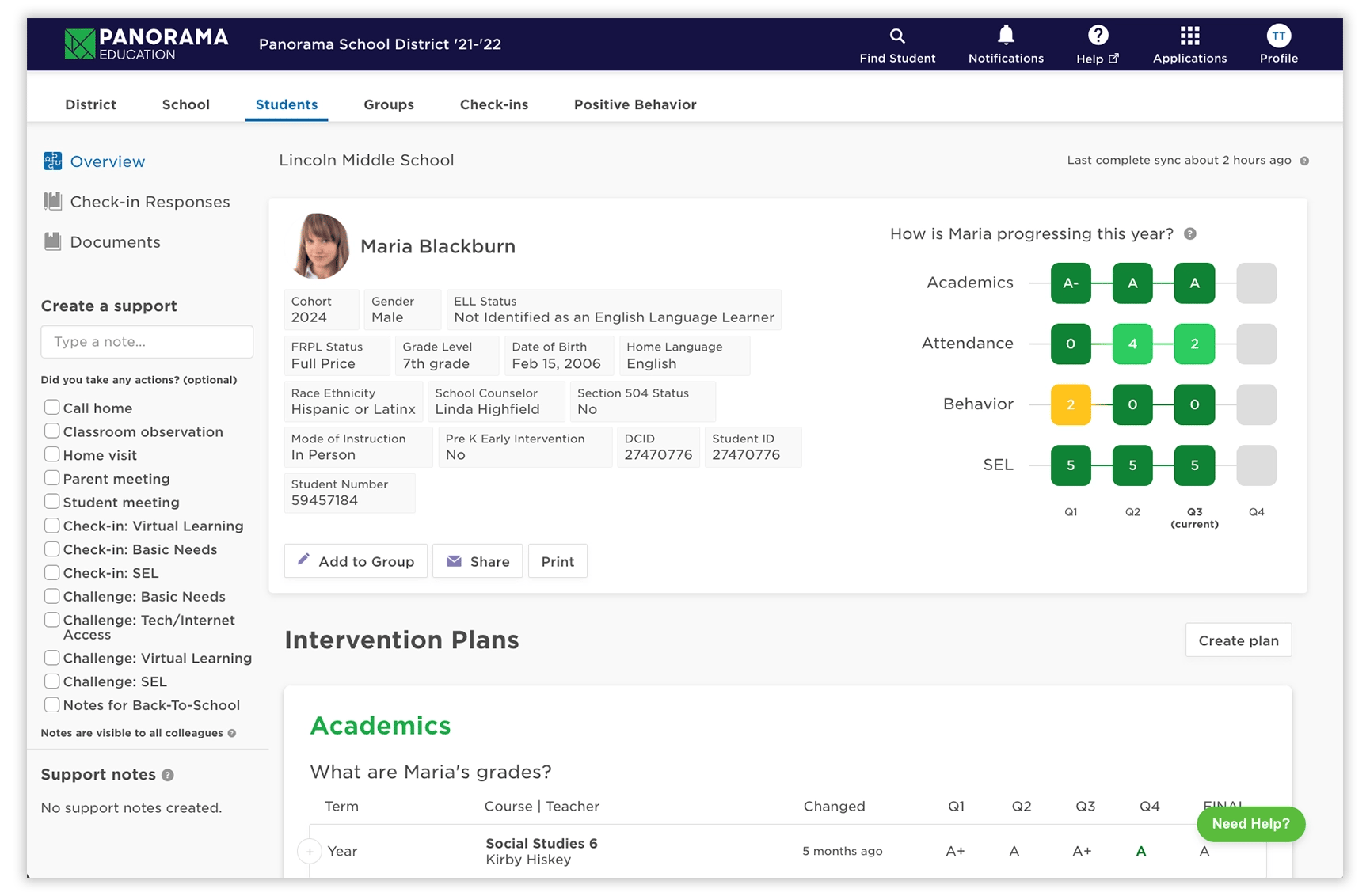
GRADUATION, COLLEGE, AND CAREER READINESS
Panorama Pathways
Panorama Pathways simplifies graduation tracking with automated transcript and schedule monitoring. Now, districts and schools can say goodbye to graduation pathway errors. And instead of checking binder after binder of schedules, counselors have more time to work with students.
Explore funding alignment:
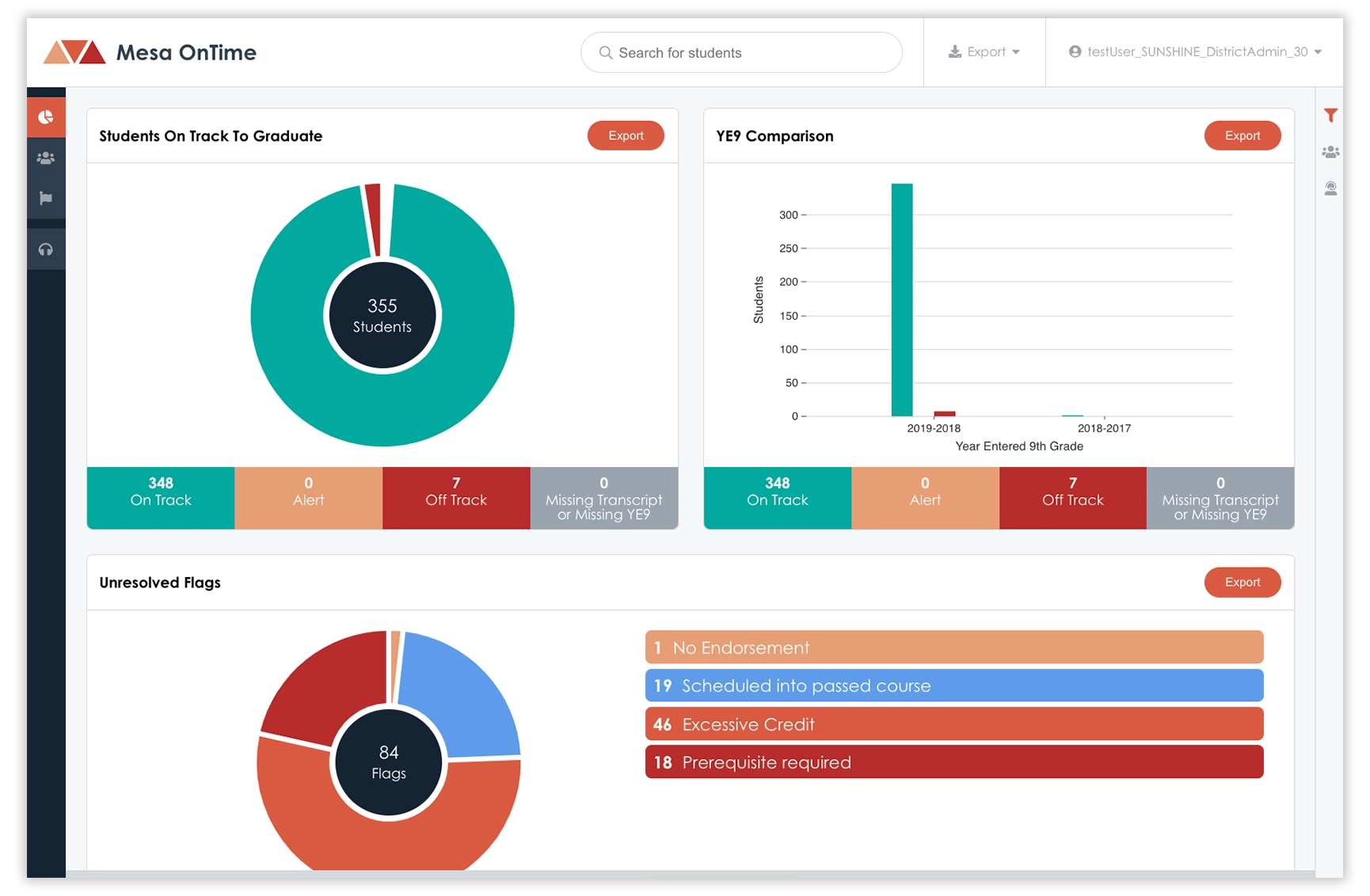
POSITIVE BEHAVIOR INTERVENTIONS AND SUPPORTS (PBIS)
Behavior Logging & Analytics
When used alongside Student Success, Panorama Behavior can reduce the number of systems you need to collect and analyze data. Behavior incident reporting and teacher dashboards offer a full view of behavior in your school or district to better understand trends.
Explore funding alignment:
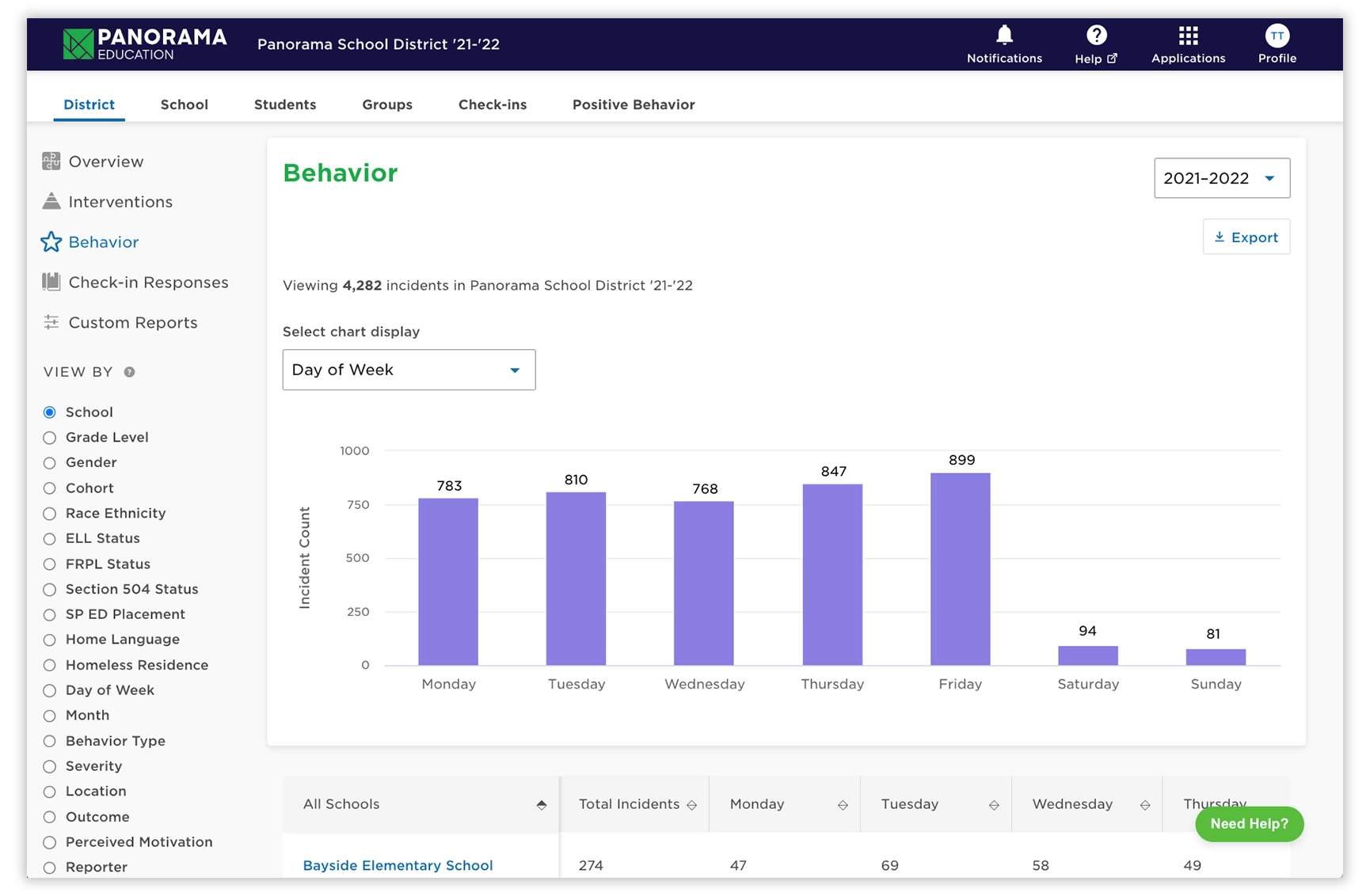
LIFE SKILLS AND EMPLOYABILITY
Panorama for Life Skills
With Panorama for Life Skills, you’ll measure, understand, and develop students’ life skills to improve academic outcomes. You’ll have the guidance you need to evolve and scale your practices—from student and staff surveys to tools and strategies to take action to best practices for continuous improvement.
Explore funding alignment:
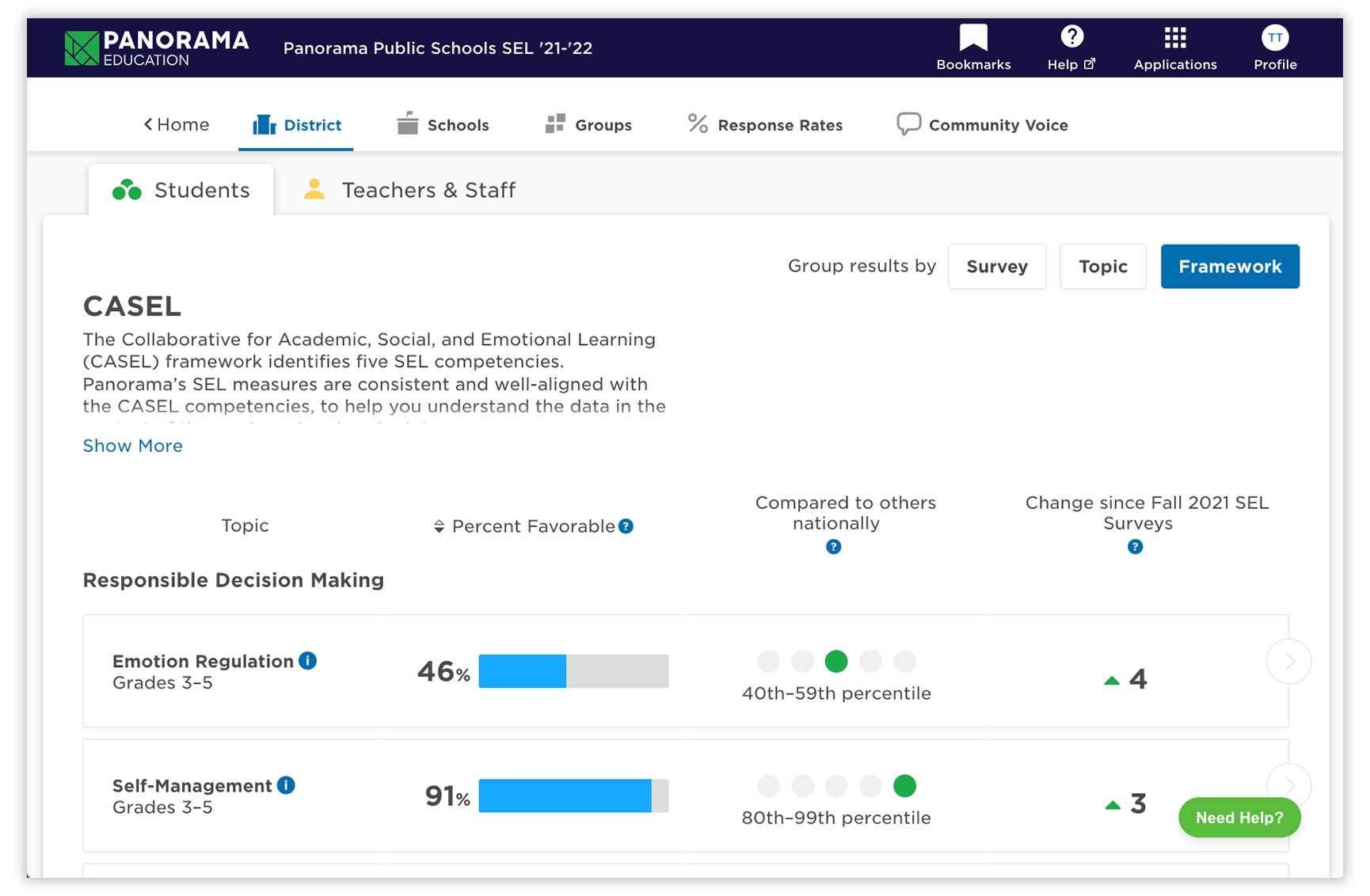
STAFF WELL-BEING AND RETENTION
Panorama Surveys
With Panorama Teacher and Staff Surveys, you can assess the quality of the work environment, help prevent teacher turnover, and offer programs and professional development to address job satisfaction.
Explore funding alignment:
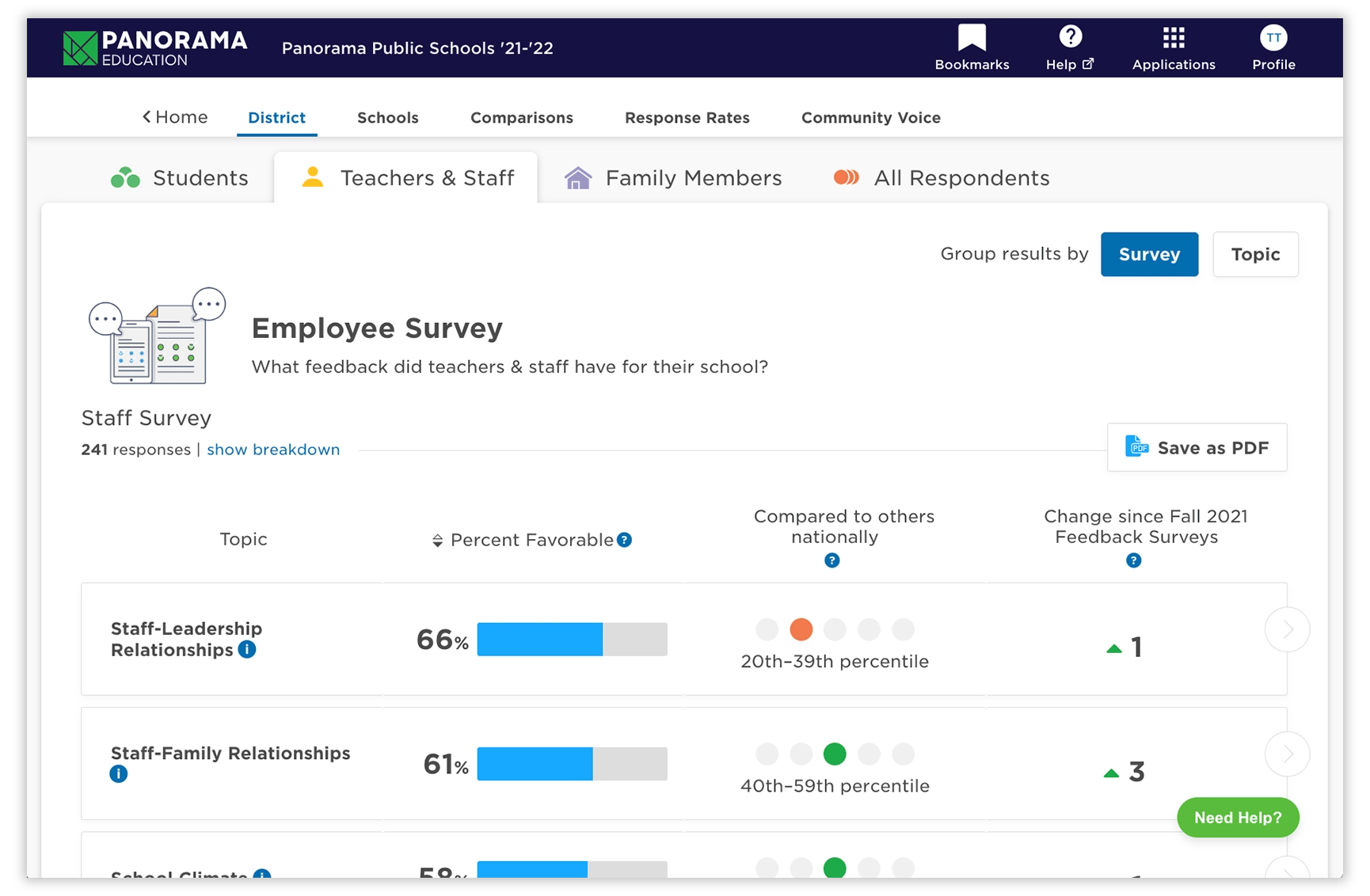
SCHOOL CLIMATE
Panorama Surveys
The Panorama School Climate Survey offers valid and reliable feedback on your school’s learning climate and students’ connections, sense of belonging, valuing of school, and perceptions of safety and the availability of support.
Explore funding alignment:
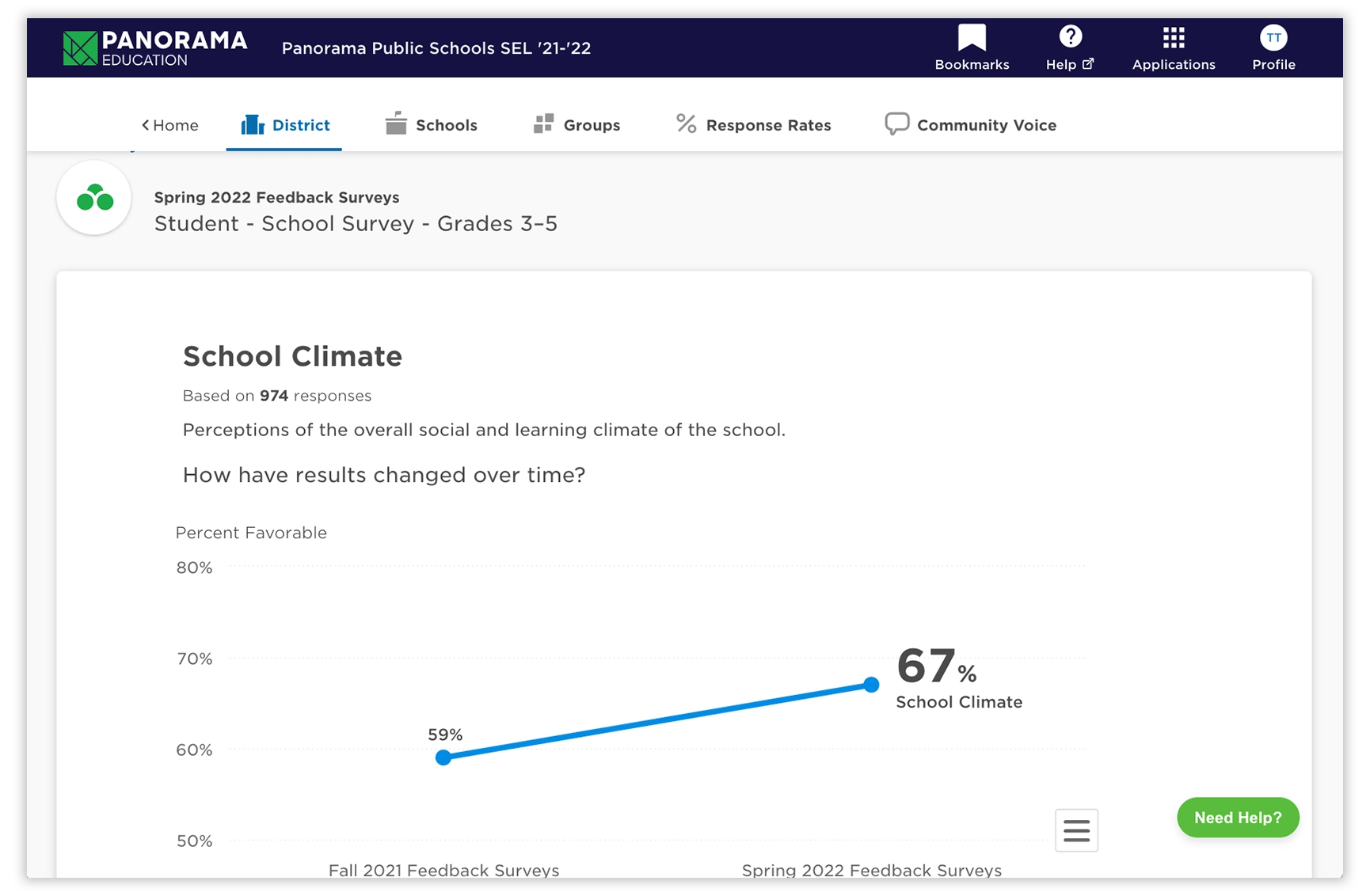
FAMILY ENGAGEMENT
Panorama Surveys
Research shows that engaging families leads to higher grades, better life skills, and a higher likelihood of graduation. The Panorama Family-School Relationships Survey will help you engage parents and guardians and develop their capacity to contribute to their children’s learning.
Explore funding alignment:
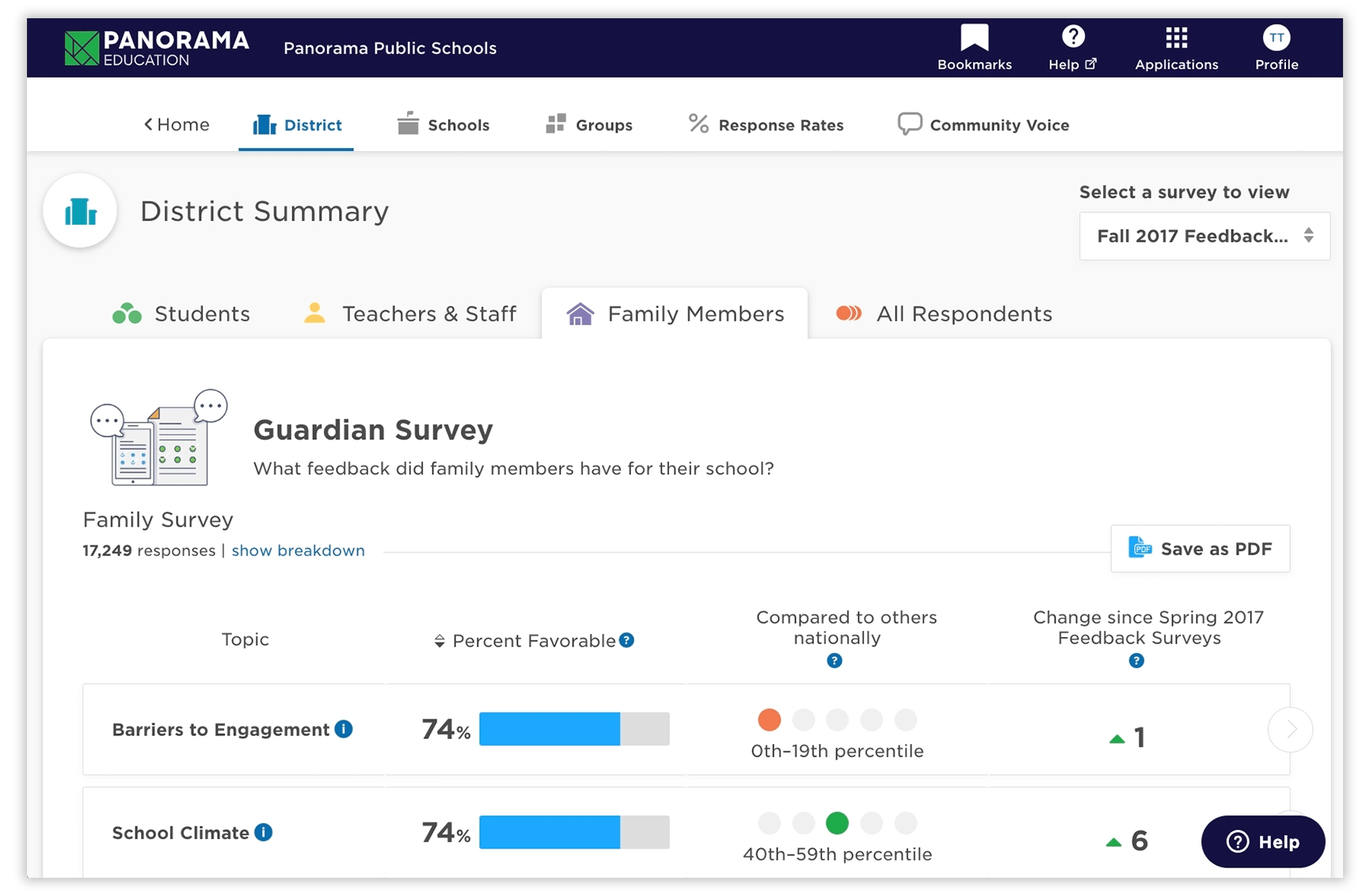
PROFESSIONAL LEARNING
Panorama Professional Development
Panorama’s workshops and strategic advising offer hands-on learning, personalized support, and system-level guidance to help educators and administrators embed Panorama tools into their day-to-day practice to support students holistically and drive system-wide improvement.
Explore funding alignment:

Title I Funding
Panorama Student Success • Panorama for Life Skills • Panorama Surveys • Panorama Behavior Logging & Analytics • Panorama Pathways • Panorama Solara • Workshops and Advising
Panorama can help schools and districts meet key Title I obligations to improve outcomes for lower-achieving children.
Meet the educational needs of low-achieving children in our Nation's highest-poverty schools, limited English proficient children, migratory children, children with disabilities, Indian children, neglected or delinquent children, and young children in need of reading assistance.
Panorama’s Surveys measure and assess key areas of educational need for low-achieving students, including Classroom Expectations and Rigor, Pedagogical Effectiveness, Interest in Subject, and Learning Strategies, among others. The Panorama Student Survey has been translated into over a dozen languages to reach all students. Similarly, Panorama Student Success, Panorama for Life Skills, and Panorama Behavior Logging & Analytics allow educators to monitor and intervene on the academic, behavioral, and attendance needs of low-achieving students.
Afford parents substantial and meaningful opportunities to participate in the education of their children.
Panorama provides many pathways for increasing family engagement in their children’s schools. The Family-School Relationships Survey helps schools understand current levels of family participation in the education of their children. Panorama also provides families with access to their student’s performance information through Panorama Student Success. These tools help school leaders build a shared culture of parent participation in school as well as engage parents in choosing the right learning environment for their children.
Close the achievement gap between high- and low-performing children, especially the achievement gaps between disadvantaged children and their more advantaged peers.
The Panorama platform provides key insights for teachers and school leaders into gaps between student groups. Educators can view data breakdowns related to students’ relative advantage, including race and ethnicity, Free or Reduced Lunch, English Language Learner, and other statuses, across each aspect of a student’s achievement in school.
Panorama Pathways automatically identifies students who are off-track to graduate or missing out on eligible opportunities, which helps to address the consistent underrepresentation of low-socioeconomic students in AP courses. Panorama Pathways can also help schools with high-Title I populations address the historically lower graduation and post-secondary achievement rates with the district median.
Panorama Solara delivers safe, effective AI to improve student outcomes. In seconds, educators can generate classroom and student-level resources like intervention plans and family letters aligned to district standards.
Significantly elevate the quality of instruction by providing staff in participating schools with substantial opportunities for professional development.
Panorama provides direct professional development to school staff as well as data reports and resources that staff can use to elevate the quality of instruction in school. Panorama enables grade-level teams, teaching coaches, and educator evaluators to engage teachers in data inquiry and to develop individualized professional learning and development based on teachers’ strengths and areas for improvement.
Provide greater decision-making authority and flexibility to schools and teachers in exchange for greater responsibility for student performance.
Panorama provides classroom-level, school-level, and district-level reports that provide teachers and school leaders with individualized data they can use to improve their support for student performance. Panorama’s analytics provide results disaggregated by student characteristics including gender, race and ethnicity, and FRPL status.
Panorama Pathways credit monitoring platform provides school counselors with individualized data to improve their support for student performance. The platform’s automation optimizes time for counselors and administrators to ensure that no student falls through the cracks.
Built on K-12 research and best practices, Panorama Solara includes ready-made prompts and tools to create lesson plans, rubrics, grade-level texts, and more—saving time for meaningful student engagement. Easily customize the tools to fit your district’s needs.
Title II Funding
Panorama Student Success • Panorama Surveys • Workshops and Advising • Panorama Solara
Panorama can help schools and districts to improve teacher & leader quality and increase student success.
Providing evidence-based professional development activities that are sustained, intensive, collaborative, job-embedded, data-driven, and classroom-focused.
Panorama’s Teacher and Staff Survey is for school and district administrators interested in understanding teacher and staff perceptions of professional learning opportunities. With this data, professional learning can be targeted to the opportunities for growth elevated by each district or school’s local staff needs.
Elevating relevant data to understand educators’ most pressing needs.
Panorama’s Teacher and Staff Survey gathers teacher, faculty, and staff perceptions of professional learning opportunities; confidence in the classroom; school climate; and relationships with colleagues, families, and school leadership. With this data, professional learning can be targeted to the opportunities for growth elevated by each district or school’s local staff needs.
Panorama Solara securely integrates with existing Panorama tools, pulling in data to deliver tailored, individualized insights for each student – all customizable to your district’s needs.
Providing data to monitor performance and ensure continuous improvement, including plans for data collection, analysis and/or an evaluation.
Panorama provides school-level and district-level reports that provide school and district leaders with data they can use to track the impact of professional development from student, staff, and family perspectives. Panorama’s analytics provide results disaggregated by student and staff characteristics.
Panorama Solara assists leaders with visibility into how AI is being used in their school or district. With Solara, leaders can see categories of queries and types of AI requests educators are putting in for auditing and reporting.
Access detailed analytics on AI activity across your district with Panorama Solara, including the themes educators are searching for. Track trends to meet governance requirements and uncover insights to better support teachers, staff, students, and families.
Provide greater decision-making authority and flexibility to schools and teachers in exchange for greater responsibility for student performance.
Panorama provides classroom-level, school-level, and district-level reports that provide teachers and school leaders with individualized data they can use to improve their support for student performance. Panorama’s analytics provide results disaggregated by student characteristics including gender, race and ethnicity, and FRPL status.
Catch transcript, schedule, and graduation pathway errors that would have otherwise required manual intervention with Panorama Pathways credit monitoring platform. Automatic progress tracking gives school counselors more time working directly with students than with paperwork.
Panorama Solara gives educators and administrators access to student and grade data to analyze for decision making, planning, and interventions.
Title III Funding
Panorama Student Success • Panorama for Life Skills • Panorama Surveys • Panorama Pathways • Workshops and Advising • Panorama Solara
Panorama can help schools and districts meet crucial Title III objectives to support multilingual learners (MLs) and promote language acquisition and academic achievement for these students.
Help MLs gain high levels of academic achievement so they can meet the same challenging standards all children must meet.
Panorama Student Success effectively tracks the progress of MLs through comprehensive data insights. Panorama’s suite of tools, including Panorama for Life Skills, allows educators to monitor and support academic progress, language proficiency growth, and the behavioral needs of MLs.
Elevate the quality of instruction by providing professional development opportunities for staff focusing on MLs’ unique needs.
Panorama Professional Development includes workshops and strategic advising to help educators understand and act on multilingual student insights to enhance language acquisition, and academic growth for this student group.
Strengthen and increase parental, family, and community engagement in programs.
Panorama’s Family-School Relationship Survey is available in 10 languages to meet the needs of diverse language communities and aid in understanding family engagement levels among MLs. Additionally, Panorama Student Success offers secure family access links to intervention plans to help multilingual families understand their child’s academic performance and growth to foster greater engagement and collaboration between school and home.
Support the unique needs of multilingual learners to meet local requirements.
With Panorama Pathways' automated credit monitoring, school counselors can quickly identify when a student needs intervention in their academic path and connect students with additional supports.
With Panorama Solara, educators can access a secure chat interface with education best practices and district-specific customizations. Using pre-built prompts, they can create personalized supports for vulnerable student populations—like intervention plans and family letters—faster and more efficiently.
Title IV Funding
Panorama Student Success • Panorama for Life Skills • Panorama Surveys • Panorama Behavior Logging & Analytics • Panorama Pathways • Panorama Solara
Panorama can help schools and districts provide enriching academic and support programs for students’ well-rounded education. Panorama helps educators monitor student and school-wide trends in behavioral incidents and positive behavior.
Supporting local education agencies (LEAs) in offering a well-rounded education and fostering safe, healthy, supportive, and drug-free environments.
Panorama’s surveys help schools and districts measure and improve key aspects of a healthy school environment, including School Safety, School Climate, and Teacher-Student Relationships. Our data dashboards provide holistic indicators of student success across academics, attendance, and behavior for students.
Expanding access to or coordinating resources for school-based counseling and mental health programs, such as through school-based mental health services partnership programs.
Panorama’s life skill measures provide school-based counselors and mental health professionals with a comprehensive assessment of students’ needs. Panorama’s dashboards allow counselors and educators to log and track the progress of their interventions. All staff are able to access Panorama’s Playbook of resources and training in the area of life and employability skills.
Disseminating best practices and evaluating program outcomes relating to any LEA activities to promote student safety and violence prevention..
Panorama helps schools and districts track the effectiveness of safety and violence programs by measuring change-over-time with valid and reliable surveys on topics like School Safety and School Climate.
Programs that help prevent bullying and harassment.
Panorama’s life skill measures also give educators a deeper understanding of each student’s foundational skills in areas like Social Awareness, Self-Management, and Social Perspective Taking—key aspects towards developing healthy and safe habits in school.
Panorama Behavior Logging & Analytics provides behavior incident reporting and teacher dashboards, giving you a full view of behavior in your school or district to better understand trends.
Establishing or improving school dropout and reentry programs.
Panorama’s early warning indicators provide school staff with actionable alerts of students’ at-risk signals for dropout. For students re-entering a school, Panorama helps educators measure Student Engagement, Teacher-Student Relationships, Sense of Belonging and Valuing of School to ensure that every student is connected to their academic learning environment and is supported by adults.
Panorama Pathways automatically flags students who are off-track for graduation, providing actionable alerts of at-risk signals for dropout to school counselors. For students re-entering a school, Panorama Pathways helps educators optimize schedules so that every student is supported.
Designing and implementing a locally tailored plan to reduce exclusionary discipline practices.
Panorama helps schools and districts monitor school-wide discipline practices to identify incidences of disproportionate discipline across student groups, as well as understand the root causes of these issues using school climate data. Panorama’s reports allow educators to track real-time trends in behavior, allowing for greater insight into practices that promote improved learning time.
Establishing learning environments and enhancing students’ effective learning skills that are essential for school readiness and academic success, such as by providing integrated systems of student and family supports.
Panorama Student Success provides a comprehensive platform for integrated systems of student and family supports, such as a multi-tiered system of supports (MTSS) and response to intervention (RTI). Panorama allows educators to monitor students’ academic and learning progress using multiple sources of data, and to plan tiered interventions and supports. Panorama also supports the measurement of students’ life skills, as well as family supports and engagement, to ensure schools are supporting students’ foundational learning skills for academic success.
With Panorama Solara, educators can access a secure chat interface with education best practices and district-specific customizations. Using pre-built prompts, they can create personalized student supports, family letters, and more faster and much more efficiently.
Title V (REAP/SRSA) Funding
Panorama Student Success • Panorama for Life Skills • Panorama Surveys • Panorama Pathways
Panorama offers solutions that align to Title V objectives to support rural education and enhance opportunities for students in rural districts.
Support the unique needs of students living in rural areas.
Panorama Student Success helps educators track academic, behavioral, and life skill needs, ensuring rural students receive tailored supports. With Panorama Pathways' automated credit monitoring, school counselors can quickly identify when rural students need an intervention in their academic path and connect them with additional supports.
Panorama Solara helps educators get more time with students, by helping solve many of the administrative tasks they face today. Whether it’s preparing for a student teacher conference, attendance planning, or more.
Address mental health and overall well-being of students in rural areas.
The Panorama Student Well-Being Survey can help educators assess well-being among rural student populations. This survey allows educators to gather crucial insights and implement targeted interventions to support the well-being needs of students in rural districts.
Improve literacy and math proficiency among students in rural areas.
With Panorama Student Success, educators can quickly identify and address academic needs, find research- and evidence-based interventions using Panorama Playbook, and track progress toward literacy and math proficiency for students in rural schools.
To further improve proficiency with Student Success and Playbook, Panorama Solara securely integrates with these tools, pulling in data to deliver tailored, individualized insights for students in rural schools.
Enhance family engagement within rural school communities.
Panorama’s Family-School Relationship Survey can help educators understand and enhance family engagement in rural areas. Additionally, Panorama Student Success offers secure family access links to intervention plans to help families understand their child’s academic performance and growth to foster greater engagement and collaboration between school and home.
Establishing or improving school dropout and reentry programs.
Panorama Pathways automatically flags students who are off-track for graduation, providing school counselors actionable alerts for students at risk of dropping out. For students re-entering a school, Panorama Pathways helps educators optimize schedules so that every student is supported.
Title VI Funding
Panorama Student Success • Panorama for Life Skills • Panorama Surveys • Panorama Pathways • Panorama Solara
Panorama aligns with Title VI objectives to ensure educational equity and support Native American students’ diverse needs.
Meet the unique educational and academic needs of Native American students.
Panorama Student Success helps educators track academic, behavior, and life skills data, ensuring Native American students receive supports tailored to their needs. With Panorama Pathways' automated credit monitoring, school counselors can quickly identify when Native American students need an intervention in their academic path and connect them with additional supports.
With Panorama Solara, educators can access a secure chat interface with education best practices and district-specific customizations. Using pre-built prompts, they can create personalized student supports related to the needs of their Native American students.
Improve literacy and math proficiency among Native students.
With Panorama Student Success, educators can quickly identify and address academic needs, find research- and evidence-based interventions using Panorama Playbook, and track progress toward literacy and math proficiency for Native American students.
To further improve proficiency with Student Success and Playbook, Panorama Solara securely integrates with these tools, pulling in data to deliver tailored, individualized insights for Native American students.
Address mental health and overall well-being of Native students.
The Panorama Student Well-Being Survey can help educators assess well-being among Native student populations. This survey allows educators to gather crucial insights and implement targeted interventions to support the well-being needs of students.
Establishing or improving school dropout and reentry programs.
Panorama Pathways automatically flags students who are off-track for graduation, providing school counselors actionable alerts for students at risk of dropping out. For students re-entering a school, Panorama Pathways helps educators optimize schedules so that every student is supported.
Enhance engagement among Native American families.
Panorama’s Family-School Relationship Survey can help educators understand and enhance engagement among Native families. Additionally, Panorama Student Success offers secure family access links to intervention plans to help families understand their child’s academic performance and growth to foster greater engagement and collaboration between school and home.
Close the achievement gap between high- and low-performing children, especially the achievement gaps between disadvantaged children and their more advantaged peers.
Panorama Pathways automatically identifies students who are off-track to graduate or missing out on eligible opportunities, which helps to address the consistent underrepresentation of low-socioeconomic students in AP courses. Panorama Pathways can also help schools with high-Title VI populations address the historically lower graduation and post-secondary achievement rates with the district median.
Individuals With Disabilities Education Act (IDEA) Part B: Coordinated Early Intervening Services (CEIS) Funding
Panorama Student Success • Panorama Behavior Logging & Analytics • Workshops and Advising • Panorama Solara
The Panorama platform can help schools and districts align with IDEA and CEIS funding requirements by identifying students needing support early, offering evidence-based interventions, and empowering data-driven decision-making.
Identifying students not currently receiving special education who need additional academic and behavioral support to help them succeed in the general education environment.
Panorama Student Success provides an all-in-one, evidence-based platform featuring unified academic, attendance, behavior, and life skills data for each student, streamlining the identification of at-risk students and facilitating targeted interventions.
Reducing referrals for special education and related services for needs that could be addressed with general education interventions.
Panorama Student Success and Behavior Logging & Analytics dashboards inform and support a proactive approach to addressing academic and behavioral challenges. Using this data alongside Panorama Playbook can help educators identify universal interventions and evidence-based strategies, potentially reducing the need for special education referrals.
Supporting MTSS/RTI for nondisabled students in need of additional academic or behavioral support (i.e., Tier 2 and 3 supports).
With the comprehensive Panorama MTSS platform, educators can quickly identify students in need of support beyond Tier 1. Panorama allows educators to monitor students’ academic and learning progress using multiple data sources, easily assign and manage evidence-based interventions across multiple tiers of support, and collaborate with interventionists, support staff, and administrators.
Providing professional development for educators and staff to enable the delivery of scientifically based academic and behavioral interventions.
Panorama Professional Learning includes workshops and strategic advising to help educators understand and act on student insights and deliver effective interventions.
Providing educational and behavioral evaluations, services, and supports, including scientifically based literacy instruction.
Panorama Student Success includes data analysis tools, district and school reporting, and nightly syncs with popular student information systems to ensure comprehensive student insights for informed evaluations and evidence-based supports, including literacy instruction.
Panorama Solara securely connects with your district’s documents and Panorama data, providing AI-powered insights at the student level. Educators can quickly draft resources for individual students such as IEPs, attendance nudge letters, and behavior improvement plans.
Perkins V Funding
Panorama Pathways • Panorama Solara
Panorama can help schools and districts by supporting opportunities for students to follow Career and Technical Education (CTE) programs of study.
Put every student on the path to success by supporting students in earning certifications that will help them in their professional careers.
In addition to tracking graduation requirements, Panorama Pathways helps districts ensure opportunities for every student by monitoring additional pathways like CTE or endorsements that strengthen the modern diploma and prepare students for the world ahead. By doing so, Panorama Pathways improves CTE outcomes for districts, even ensuring full funding opportunities in states with weighted CTE funding allocations.
Panorama Solara delivers safe, effective AI to improve student outcomes. In seconds, educators can generate classroom and student-level resources like intervention and behavior plans aligned to district standards to ensure on time graduation
Gaining Early Awareness and Readiness for Undergraduate Programs (GEAR UP)
Panorama Pathways • Panorama Solara • Panorama Student Success
Panorama can help schools and districts by supporting student college and career readiness.
Providing educational and behavioral evaluations, services, and supports, including scientifically based literacy instruction.
Panorama Solara delivers safe, effective AI to improve student outcomes. In seconds, educators can generate classroom and student-level resources like intervention and behavior plans aligned to district standards to ensure on time graduation.
Panorama Pathways automatically identifies students who are off-track to graduate or missing out on eligible opportunities, which helps to address the consistent underrepresentation of low-socioeconomic students. Panorama Pathways can also help schools address historically lower graduation and post-secondary achievement rates with the district median.
Panorama Pathways credit monitoring platform provides school counselors with individualized data to improve their support for student performance. The platform’s automation optimizes time for counselors and administrators to ensure that no student falls through the cracks.
Increase parent knowledge of postsecondary education options, preparation, and financing.
With Panorama Solara, educators can access a secure chat interface with education best practices and district-specific customizations. Using pre-built prompts, they can create personalized student supports, family letters, and more faster and much more efficiently.
Panorama Pathways offers access to information about a student’s career and technical education paths, various distinctions and endorsements, and context around triggered flags. This comprehensive view helps educators guide each student’s unique journey, better engage with families, and provide support for on-time graduation and beyond.
Panorama Student Success offers secure family access links to intervention plans to help families understand their child’s academic performance and growth to foster greater engagement and collaboration between school and home.
Increase student achievement, graduation rates, and students' preparation for postsecondary education.
Use Panorama Student Success to proactively identify who needs support with data updated nightly in one platform. Quickly deliver support using simple intervention planning workflows and research- and evidence-based strategies. Teachers, interventionists, counselors, and administrators can easily view school-level trends and identify students who are “on track” and “at risk” of attendance issues. A key feature of Panorama Student Success is its ability to track students below benchmark reports for ELA and math, take immediate action and build support plans.
Panorama Student Surveys help schools understand students' perceptions of college and career readiness. With this data, at-risk students can be identified easily and can be targeted for intervention to ensure on time graduation and encourage post secondary opportunity and success.
CARES Act, Elementary and Secondary School Emergency Relief Funding II, and American Rescue Plan
Panorama Student Success • Panorama for Life Skills • Panorama Surveys
Navigate the expiration of CARES/ESSER funds with Panorama. As these funds expire, Panorama is here to help you find new funding avenues to sustain your education tools for the 2024-2025 school year. Get help from our Grants Team >
Learn how Panorama Education Software is an allowable use for ESSER I, II, and III federal funding.
Panorama Education software, including student surveys, Panorama for Life Skills, and Panorama Student Success, is an allowable use under:
- CARES Act Section 18003(d)(9)
- CRRSA Act Section 313(d)(9)
- ARP Act Section 2001(e)(2)(K)
Purchasing educational technology, which could include hardware, software, and connectivity, for students served by the LEA that aids in regular, substantive educational interaction between students and educators, including low-income students and students with disabilities. This could also include assistive technology or adaptive equipment.
Panorama provides classroom-level, school-level, and district-level reports that provide teachers and school leaders with individualized data they can use to improve their support for student’s academic, and life skills. Panorama’s analytics provide results disaggregated by student characteristics including gender, race and ethnicity, and FRPL status. Additionally, with Panorama for Life Skills and the Panorama MTSS platform, educators can easily assign and manage evidence-based interventions across multiple tiers of support and can collaborate with interventionists, support staff, and administrators.
Panorama family and staff surveys qualify as an allowable use under:
- CARES Act Section 18003(d)(1).
- CRRSA Act Section 313(d)(1).
- ARP Act Section 2001(e)(2)(A) through Section 2001(e)(2)(D).
Any activities authorized under the Elementary and Secondary Education Act, IDEA, Carl D. Perkins Career and Technical Education Act, and Adult Education and Family Literacy Act.
Many schools and districts leverage Title I funds for Panorama products and services already. Under ESSER I, II, and III, schools and districts can expand Title I allowable products and services across their entire districts. Please see below (Title I Funding) for additional information on how all Panorama products, including staff and family surveys, as well as professional development, qualify as an allowable use.
Additional Foundation & Competitive Grants
Panorama Student Success • Panorama for Life Skills • Panorama Surveys • Panorama Pathways • Panorama Solara
Foundation grants (also referred to as “corporate” or “private” grants) are financial contributions that corporations award to non-profit organizations (such as schools and school districts) that operate in their local region or pursue similar missions.
Questions about funding for Panorama?

